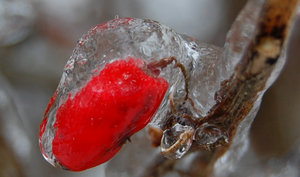Those that live in the tropics are exposed to a plethora of fresh fruits and vegetables all year long. Unfortunately, not all of us live in those regions.
The Ideal Situation
How can you eat a natural raw diet if you live in cold regions where locally grown fruits and vegetables simply are not available most of the year? While you might really want to move to Hawaii, Florida or Costa Rica where you can get wonderful raw fruit and vegetables that are grown nearby all the time, you may have a job that means you must reside in Canada, Nebraska, or another cold area.
Air travel, thankfully, has made it possible for raw-foodists living in cold climates to obtain imported fresh, natural foods. When it is cold, the body uses more calories to stay warm, so you may find you think you should eat more. That isn’t necessarily true. Those extra calories may come from carbohydrate-rich fruit like bananas.
Must I Eat Only Locally Grown Foods?
Some philosophies, such as macrobiotics, believe that eating exotic or imported foods are unhealthy. This requires a little thought. Because the human diet is designed for humans – all over the world – and many fruits and vegetables that grow in your locale may, in fact, not be indigenous to that region, this idea simply doesn’t make sense.
For an example, let’s look at mangoes. These fruit are tasty, sweet, full of fiber and great for you. They taste grand! And it’s really nice if you can simply walk outside and pull a ripe one from your tree or purchase some from your neighborhood market that are locally grown and harvested ripe. The fruit has the most nutrition this way.
But, for those people that eat imported mangoes that have been stored during shipment, it is still a great food that is tasty, sweet, full of fiber and great for you. In fact, a mango purchased in Montreal could have been picked only a few days before because technology provides such great ways to distribute food to other locales.
In truth, much of the foods that are not healthy, are processed and have additives are much older than that exotic fruit you find in your grocer’s produce section. Of course, it costs energy to transport food, and if you wish to live truly green, you can always choose those fruits, vegetables, nuts and seeds that are grown nearby as much as possible and choose to avoid some of the most exotic choices that are grown on the other side of the planet.
In some locations, especially in the long northern winters, local produce is almost nonexistent. Even lettuce is several weeks old. If you have a climate controlled greenhouse, you can grow some of your own food, but most people aren’t in this situation. You can, however, choose to grow fresh sunflower greens which are a fresh green vegetable. It’s simple and easy and very healthy to include these in your diet and you can cut the greens immediately before consumption so they are the freshest and tastiest of winter vegetables.
Handling Cold
There are some people, even raw-foodists that say eating spicy foods, such as those with garlic or cayenne pepper, is a good practice in the winter. However, adding spices to food means that the food is no longer natural, unprocessed and healthy.
In truth, eating these toxic foods does not make a person warmer; they produce the exact opposite. The feeling of “nice and warm” is the body activating your metabolism in order to rid itself of the poison!
Raw-foodists that complain of ‘freezing’ in the winter often eat their foods cold. When food that has been kept in refrigeration is eaten while cold, the body will feel cold. Simply let the food warm up before eating.
Since raw, natural foods do not become rancid like meats do, you can remove from the refrigerator all the food you plan to eat the next day and let it reach room temperature. If you need to eat something straight from the refrigerator, place it in warm water for about ten minutes.
When feeling chilly, exercise can generate warmth. An aerobic session can raise metabolism as much as 10% above the resting rate. This means that if it were possible to work out hard for one hour without dissipating any heat at all, you’d raise you body temperature to 140 degrees Fahrenheit! So, get up and exercise! You’ll feel better, be warmer, and enjoy better health.
Tropical or Temperate Fruits: Which is Better?
There are some people that say that one type of fruit is better than another based on the climate where it was grown. One theory is that tropical fruit is better than fruit grown in temperate areas because our bodies are mot genetically adapted to them. This belief would mean that papayas, mangoes, and bananas would be best while apples, pears and most berries would be less beneficial.
Because there is not any substantial proof that fruit grown in any particular region is better for the human body, I propose that they are all good. Enjoy as wide a variety of raw fruits as is available, depending on where you are and the season.
Some of the most delicious fruits, cherimoya, litchi, jackfruit, durian, and many others, are not well known but as people learn to eat more fruit, more varieties will become available to everyone.

